May 2009
Monthly Archive
Sun 31 May 2009
Posted by Jason G. under
TradingNo Comments
Fascinating stuff from Barron’s…
But a less-noticed intrigue occurs on the date when Russell measures stock-market caps to determine index membership. It is May 29 this year. Working as a trader at Morgan Stanley some years back, Rosenthal noticed stocks that surged suspiciously up the ranks on the day Russell took its snapshot. “People actually forced stuff in…that is just evil,” says the finance prof. “It isn’t like you figured something out, but that you made it happen.”
Those suspicions seem borne out by the data of Zhan Onayev and Vladimir Zdorovtsov, researchers at State Street who studied the past nine years of Russell reconstitutions. Among the stocks that just squeaked above the Russell 2000 threshold, a disproportionate share of the gains for May occurred on that measurement date — in- deed, in the last minutes of that day.
…Last year, about 200 new additions made it over the Russell 2000 threshold, which was the market cap of the 3000th stock at the close of May 30, 2008-or $167 million. In this year’s still-recovering market, analysts like Citigroup’s Lori Calvasina predict the cutoff will be down around $72 million. A would-be manipulator might hoard illiquid stocks with market caps under that level, in hope of pushing them up on May 29.
The easy way to curtail this sort of stuff would be to take the average market cap over a period of time (say, 6 months) as criteria for inclusion…
Kinda similar, Friday’s close was nothing short of spectacular. Karl Denninger has more over at his blog, but suffice it to say, a rather large order showed up in the futures for the SPX in the last minute (/ES is the S&P 500 e-mini futures contract). The total margin for the number of contracts pushed through was close to $22.5 million, with a dislocation that cost the order giver a whopping $1.25 million disadvantage for trying to push it through in the way they did.
I assume, and Dennninger agrees, that it was most likely a short position that got liquidated. But I think it raises more than a few eyebrows amongst those that are usually impervious to conspiracy theories…
Mon 25 May 2009
Posted by Jason G. under
CommentaryNo Comments
A friend was nice enough to send me a blog posting about the USD no longer being the Russian Reserve Currency. Shocking stuff, surely, but let’s take a look at the cited MarketOracle.co.uk article…
The US dollar is not Russia?s basic reserve currency anymore. The euro-based share of reserve assets of Russia?s Central Bank increased to the level of 47.5 percent as of January 1, 2009 and exceeded the investments in dollar assets, which made up 41.5 percent, The Vedomosti newspaper wrote.
The dollar has thus lost the status of the basic reserve currency for the Russian Central Bank, the annual report, which the bank provided to the State Duma, said.
In accordance with the report, about 47.5 percent of the currency assets of the Russian Central Bank were based on the euro, whereas the dollar-based assets made up 41.5 percent as of the beginning of the current year. The situation was totally different at the beginning of the previous year: 47 percent of investments were made in US dollars, while the euro investments were evaluated at 42 percent.
The dollar share had increased to 49 percent and remained so as of October 1. The euro share made up 40 percent. The rest of investments were based on the British pound, the Japanese yen and the Swiss frank.
The report also said that the reserve currency assets of the Russian Central Bank were cut by $56.6 billion. The losses mostly occurred at the end of the year, when the Central Bank was forced to conduct massive interventions to curb the run of traders who rushed to buy up foreign currencies. The currency assets of the Central Bank had grown to $537.6 billion by October 2008. Therefore, the index dropped by almost $133 billion within the recent three months.
The majority of Russian companies, banks and most of the Russian population started to purchase enormous amounts of foreign currencies at the end of 2008. The dollar gained 16 percent and the euro 13.5 percent over the fourth quarter. The demand on the US dollar was extremely high, and the Central Bank was forced to spend a big part of its dollar assets, experts say.
There’s another way to read the Russian currency reserves situation…
The Russian central bank didn’t change it’s reserve ratios because of some macro analysis, they did so because of the domestic demand for foreign currencies (specifically the USD) and their intention to defend their currency.
Last October, Russia had US$500b in currency reserves (I’m rounding to make the math easier but less precise), 49% of it in USD ($245b) and 40% in EUR ($200b).
At the beginning of 2009, Russians started trying to buy foreign currencies, “The demand on the US dollar was extremely high.” To defend their currency, Russia removed funds from their currency reserve to meet the foreign currency demand and keep the ruble from collapsing.
Within the last several months, the Russian foreign currency reserves dropped by $133b. Let’s say 80% of the demand was for USD (“extremely high”). That would be $106b of the amount the reserves fell. Let’s say the other 20% is EUR, or $27b.
After transferring out $106b of USD, the Russian reserve would have $139b in USD. After transferring out $27b in EUR, they would have $173b in EUR. After these transactions, the new % split for the currency reserve would be 38% USD and 47% in EUR (relatively close to the percentages cited in the article, close enough for my loose arithmetic).
Instead of being proof of low demand for the USD, this article is actually evidence of incredibly high demand for the USD.
I think I’ve said it before… the USD is the worst currency in the world, except for all the others.
Sat 23 May 2009
Posted by Jason G. under
CommentaryNo Comments
Think that we’ve finally reached the bottom of the housing market?
Let’s go back to how things looked in October 2007… we had a huge wave of subprime mortgages resetting, with a peak at about $35b (per month) in resets occurring in mid-2008. A majority of the resets were subprime.
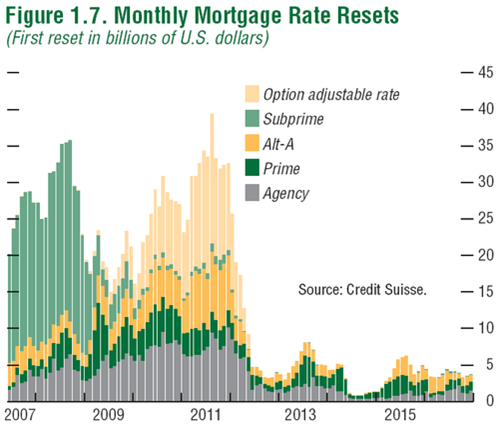
And now the current situation, thanks to Calculated Risk:
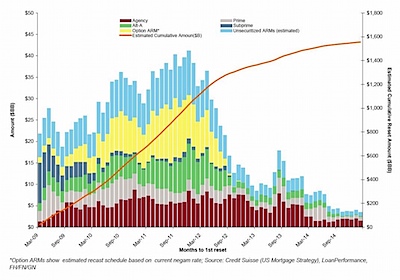
Here we see another wave of resets coming, this time peaking at $40b in resets near the end of 2011. Subprime is a much smaller portion of the resets, but we still see between $20b and $25b of mortgages being reset every month through the rest of 2009 and 2010.
If mortgage rates stay low, this might not be a problem… but it doesn’t seem to me like we’re in the clear yet.
Sat 16 May 2009
Posted by Jason G. under
CommentaryNo Comments
Proving that Denial isn’t just a river in Egypt, only 25% of pre-retirees are considering postponing their retirement age despite being woefully underprepared financially for retirement.
From a McKinsey Quarterly Economic Study:
Although consumers have taken some … steps, these could be masking a deeper failure to understand the state of retirement security. McKinsey?s retirement readiness index (RRI)?which uses Social Security, defined benefits, defined contributions, and other financial assets to measure the financial preparedness of households for retirement?is currently at 63 for an average household in January 2009. Consumers must have an RRI of 100 to maintain their current standard of living at retirement. An RRI below 80 calls for large reductions in spending on basic needs, such as housing, food, and health care.
Yet our survey showed that only about a quarter of US consumers are considering postponing retirement as a result of the crisis: the expected retirement age, 64, hasn?t changed since 2007 (Exhibit 2). Despite the fall in home values, the proportion of people planning to finance their retirement through home equity has increased slightly.
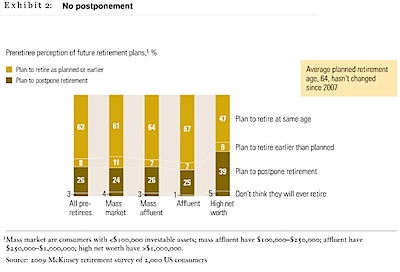
What is the prevailing attitude and what did these pre-retirees do about it?
…consumer anxiety about interest rate risks and a lack of guaranteed income has more than doubled, to around 60 percent, from the levels prevailing three to five years ago; worries about market and inflationary pressures have jumped by half, to about 75 percent…
…in the past six months, only 1 percent have moved assets away from their primary financial institution, just 37 percent have changed their investment portfolios, and no more than 20 percent have changed their retirement portfolios. Those who did make changes have tried to reduce their risk levels by rebalancing allocations toward conservative assets (38 percent), products with guaranteed rates of return (32 percent), and holdings of cash and cash equivalents (23 percent) (Exhibit 1). Most preretirees have also responded to the financial crisis by curbing their lifestyles: some 60 percent reduced spending in the six months leading up to January 2009, and 73 percent paid down debt.
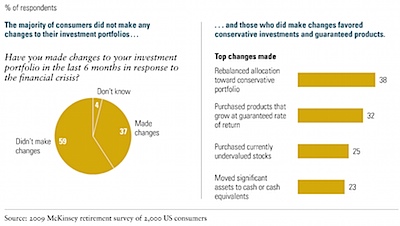
A separate nugget of blame from the same article:
…just 1 percent of preretirees hold their individual advisers primarily responsible for the impact of the crisis on them, compared with 43 percent who blame the government and regulators, and 27 percent who blame financial institutions.
I wonder who or what the other 30% blame?
Thu 14 May 2009
Posted by Jason G. under
CommentaryNo Comments
John Hussman has another great weekly letter this week, with many salient points. Read the whole thing and you won’t be disappointed.
Here are a few choice quotes:
Banks Pass Stress Test – Regulators Fail Ethics Test
Last week, financial stocks enjoyed a powerful advance and short squeeze on the announcement of the results of the ?stress test? of major banks. It is important to begin by noting that this was not a regulatory procedure with teeth. It was initially a response to Congressional demands to introduce greater objectivity into the use of public capital for these bailouts, and gradually morphed into nothing more than a ?confidence building? exercise. And keeping with the emphasis on keeping the numbers happy, as opposed to providing full and fair disclosure, the Wall Street Journal reported on Saturday, ?The Federal Reserve significantly scaled back the size of the capital hole facing some of the nation’s biggest banks shortly before concluding its stress tests, following two weeks of intense bargaining. In addition, according to bank and government officials, the Fed used a different measurement of bank-capital levels than analysts and investors had been expecting, resulting in much smaller capital deficits.?
…Now, just think of this for a minute. Even if you assume that the ?risk-weighted assets? of the banks are about two-thirds of their total assets (as the stress-test does), we’re still looking at $7.8 trillion in total assets at risk in these banks, and despite being on the edge of insolvency only weeks ago, we are asked to believe that they will need less than 1% of this amount ? $74.6 billion ? of additional capital even in a worst case scenario…
…Of course, Citi’s entire market cap is only $22 billion, so the ?$5.5 billion? that Citi is reported to need under the stress test is what it would require after a 5-to-1 dilution in its common stock (87+22/22). Essentially, we’ve got a company with a common equity buffer of just over 1% of total assets, that just 8 weeks ago was on the verge of receivership, and investors are urged to believe that there are enough voodoo dolls in the vault to make the company solvent even in a further weakened economy.
Hussman delves into more of the mechanics of the math, but arrives at this logical conclusion that everyone should have if the stress tests were actually to be believed:
Great. Then no more government money should be needed. Outstanding. Not a dime more of public funds beyond what remains in the TARP. No need to use public money to buy toxic assets either.
I for one heartily agree.
Wed 13 May 2009
Posted by Jason G. under
CommentaryNo Comments
Barry Ritholtz recently posted the following amusing anecdote:
In a small town on the South Coast of France, the holiday season is in full swing, but it is raining so there is not too much business taking place.
Everyone is heavily in debt.
Luckily, a rich Russian tourist arrives in the foyer of the small local hotel. He asks for a room and puts a Euro100 note on the reception counter, takes a key and goes to inspect the room located up the stairs on the third floor.
- The hotel owner takes the banknote in a hurry and rushes to his meat supplier to whom he owes E100.
- The butcher takes the money and races to his supplier to pay his debt.
- The wholesaler rushes to the farmer to pay E100 for pigs he purchased some time ago.
- The farmer triumphantly gives the E100 note to a local prostitute who gave him her services on credit.
- The prostitute quickly goes to the hotel, as she was owing the hotel for her hourly room used to entertain clients.
At that moment, the rich Russian comes down to reception and informs the hotel owner that the room is unsatisfactory and takes his E100 back and departs.
There was no profit or income. But everyone no longer has any debt and the small town?s people look optimistically towards their future.
Could this be the solution to the global financial crisis?
I was reminded of the posting when I read the following conclusion from Jeremy Grantham’s latest quarterly letter.
Let me [emphasize] once again the difference between real wealth and the real economy on one hand, and illusionary wealth and debt on the other. If we had let all the reckless bankers go out of business, we would not have blown up our houses or our factories, or carted off our machine tools to Russia, nor would we have machine gunned any of our educated workforce, even our bankers! When the smoke had cleared, those with money would have bought up the bankrupt assets at cents on the dollar and we would have had a sharp recovery in the economy. Moral hazard would have been crushed, lessons learned for a generation or two, and assets would be in stronger, more ef? cient hands. Debt is accounting, not reality. Real economies are much more resilient than they are given credit for. We allow ourselves to be terri? ed by the “?nancial-industrial complex” as Eisenhower might have said, much to their advantage.
At the end of the day, the amount of debt destruction or deleveraging in the economy doesn’t change the underlying assets surrounding us. (Note that Grantham is talking about this in the aggregate, for the entire economy and country.) Illusions of wealth disappear, and ownership of those real assets often change hands… a fact that the “financial-industrial complex” is well aware of, and takes advantage of.
Tue 12 May 2009
Posted by Jason G. under
CommentaryNo Comments
Today is the second time that I’ve found out one of my financial institutions is going out of business, from blogger Mike Shedlock (Mish).
Today’s casualty? Small business credit card provider Advanta. Too bad, they were innovative with their IdeaBlob sponsorship as well as support for Kiva. Unfortunately, when people aren’t paying their bills it is hard to be a credit card lender.
Mon 11 May 2009
Posted by Jason G. under
MacroNo Comments
It’s worth revisiting the inflation vs. deflation argument as things have been changing quite a bit over the last few months. Below is the chart of TIP:TLT that is my measure of inflation expectations. Going into the end of 2008, we saw a rather significant deflation scare. Anecdotal evidence abounds for prices and wages falling, and indeed it may be more than just a scare.
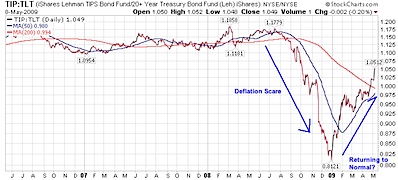
You might notice that the ratio has rebounded strongly in 2009, indicating that the investing masses may have a relative preference for TIPs over normal bonds. Despite the message the market is sending (as observed by the ratio), I haven’t heard much rumbling about inflation, except from the contrarian camp.
The real question is whether we’re returning to a “normal” expectation of inflation, or if people are just not as convinced about deflation as they were during the crash of 08.
Obviously time will tell, but if the ratio were to reverse strongly, that would be a good indication of another deflation scare. Likewise, it will be interesting to see where the new trading range is as the market figures out the “new normal”.
Tue 5 May 2009
Posted by Jason G. under
Commentary1 Comment
Demographics lie behind the major trends in economy, politics, and in the world at large… and this new info from The Wilson Quarterly will certainly drive some big trends in the near future… (Emphasis added by me.)
This stuff fascinates me, so I’m pulling several quotes from the piece:
Something dramatic has happened to the world?s birthrates. Defying predictions of demographic decline, northern Europeans have started having more babies. Britain and France are now projecting steady population growth through the middle of the century. In North America, the trends are similar. In 2050, according to United Nations projections, it is possible that nearly as many babies will be born in the United States as in China. Indeed, the population of the world?s current demographic colossus will be shrinking. And China is but one particularly sharp example of a widespread fall in birthrates that is occurring across most of the developing world, including much of Asia, Latin America, and the Middle East.
…The decline of Muslim birthrates is a global phenomenon. …recent UN data suggest that Arab birthrates are falling fast, and that the number of births among women under the age of 20 is dropping even more sharply.
The falling fertility rates in large segments of the Islamic world have been matched by another significant shift: Across northern and western Europe, women have suddenly started having more babies.
…In 2007, France?s national statistical authority announced that the country had overtaken Ireland to boast the highest birthrate in Europe. In France, the fertility rate has risen from 1.7 in 1993 to 2.1 in 2007, its highest level since before 1980, despite a steady fall in birthrates among women not born in France. France?s National Institute of Demographic Studies reports that the immigrant population is responsible for only five percent of the rise in the ?birthrate.
…A similar upturn is under way in the United States, where the fertility rate has climbed to its highest level since 1971, reaching 2.1 in 2006, according to the National Center for Health Statistics. New projections by the Pew Research Center suggest that if current trends continue, the population of the United States will rise from today?s total of some 300 million to 438 million in 2050. ?Eighty-?two percent of that increase will be produced by new immigrants and their U.S.-born descendants.
…Russia… within little more than a decade the ?working-?age population will be shrinking by up to one million people annually. Russia is suffering a demographic decline on a scale that is normally associated with the effects of a major ?war.
Via Kedrosky.
Mon 4 May 2009
Posted by Jason G. under
ResearchNo Comments
Just a quick post, I found this website and it looks like a good source of information on Municipal Bonds, specifically buying individual bonds directly rather than via a fund.
MunicipalBonds.com
Looks like you can search for bonds by state and by type (revenue, callable, etc.). They even have the yield curve for individual states. Seems like a nice resource if you’re interested in investing directly in muni bonds.
Next Page »




